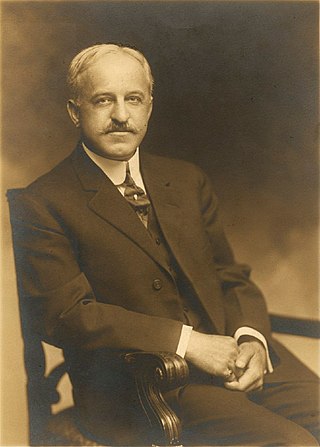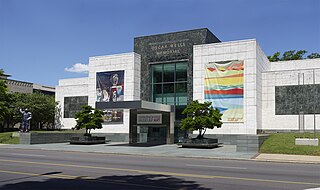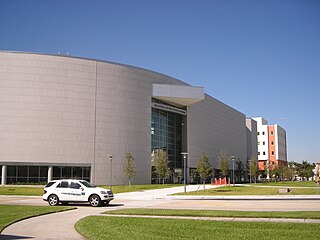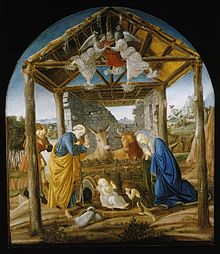
Dale Chihuly is an American glass artist and entrepreneur. He is well known in the field of blown glass, "moving it into the realm of large-scale sculpture".

The National Gallery of Art is an art museum in Washington, D.C., United States, located on the National Mall, between 3rd and 9th Streets, at Constitution Avenue NW. Open to the public and free of charge, the museum was privately established in 1937 for the American people by a joint resolution of the United States Congress. Andrew W. Mellon donated a substantial art collection and funds for construction. The core collection includes major works of art donated by Paul Mellon, Ailsa Mellon Bruce, Lessing J. Rosenwald, Samuel Henry Kress, Rush Harrison Kress, Peter Arrell Browne Widener, Joseph E. Widener, and Chester Dale. The Gallery's collection of paintings, drawings, prints, photographs, sculpture, medals, and decorative arts traces the development of Western art from the Middle Ages to the present, including the only painting by Leonardo da Vinci in the Americas and the largest mobile created by Alexander Calder.

The Art Gallery of Ontario is an art museum in Toronto, Ontario, Canada, located in the Grange Park neighbourhood of downtown Toronto, on Dundas Street West. The building complex takes up 45,000 square metres (480,000 sq ft) of physical space, making it one of the largest art museums in North America and the second-largest art museum in Toronto, after the Royal Ontario Museum. In addition to exhibition spaces, the museum also houses an artist-in-residence office and studio, dining facilities, event spaces, gift shop, library and archives, theatre and lecture hall, research centre, and a workshop.

Kemper Museum of Contemporary Art opened in 1994 in Kansas City, Missouri. With a $5 million annual budget and approximately 75,000 visitors each year, it is Missouri's first and largest contemporary museum.

The Cleveland Museum of Art (CMA) is an art museum in Cleveland, Ohio, United States, located in the Wade Park District, in the University Circle neighborhood on the city's east side. Internationally renowned for its substantial holdings of Asian and Egyptian art, the museum houses a diverse permanent collection of more than 61,000 works of art from around the world. The museum provides free general admission to the public. With a $755 million endowment, it is the fourth-wealthiest art museum in the United States. With about 770,000 visitors annually (2018), it is one of the most visited art museums in the world.

Samuel Henry Kress was a businessman, philanthropist, and founder of the S. H. Kress & Co. five and ten cent store chain. With his fortune, Kress amassed one of the most significant collections of Italian Renaissance and European artwork assembled in the 20th century. In the 1950s and 1960s, a foundation established by Kress would donate 776 works of art from the Kress collection to 18 regional art museums in the United States.

The Art Gallery of Greater Victoria (AGGV) is an art museum located in Victoria, British Columbia, Canada. Situated in Rockland, Victoria, the museum occupies a 2,474.5 square metres (26,635 sq ft) building complex; made up of the Spencer Mansion, and the Exhibition Galleries. The former building component was built in 1889, while the latter component was erected in the mid-20th century.

The Birmingham Museum of Art is a museum in Birmingham, Alabama. Its collection includes more than 24,000 paintings, sculptures, prints, drawings, and decorative arts representing various cultures, including Asian, European, American, African, Pre-Columbian, and Native American. The museum is also home to some Renaissance and Baroque paintings, sculptures,and decorative arts from the late 13th century to c. 1750.

The Museum of Fine Arts, Houston (MFAH), is an art museum located in the Houston Museum District of Houston, Texas. With the recent completion of an eight-year campus redevelopment project, including the opening of the Nancy and Rich Kinder Building in 2020, it is the 12th largest art museum in the world based on square feet of gallery space. The permanent collection of the museum spans more than 6,000 years of history with approximately 70,000 works from six continents.

The Allentown Art Museum of the Lehigh Valley is an art museum located in Allentown, Pennsylvania. It was founded in 1934 by a group organized by Walter Emerson Baum, a Pennsylvania impressionist painter.
The Sioux City Art Center began as a Works Progress Administration (WPA) project in 1937 when the Art Center Association of Sioux City, the Sioux City Junior League, as well as other community supporters, received a grant of $3,000 to create the first art center. After the Federal Assistance Program ended in 1940, the Sioux City City Council voted to fund the Art Center and established the Board of Trustees, the City's fiscal governing board for the Art Center in 1941. It is located in Sioux City, Iowa.

The Museum of Contemporary Art Jacksonville, also known as MOCA Jacksonville, is a contemporary art museum in Jacksonville, Florida, funded and operated as a "cultural institute" of the University of North Florida. One of the largest contemporary art institutions in the Southeastern United States, it presents exhibitions by international, national and regional artists.

The Kalamazoo Institute of Arts (KIA) is a non-profit art museum and school in downtown Kalamazoo, Michigan, United States.

The Patricia and Phillip Frost Art Museum is an art museum located in the Modesto A. Maidique campus of Florida International University (FIU) in Miami, Florida. Founded in 1977 as 'The Art Museum at Florida International University', it was renamed 'The Patricia & Phillip Frost Art Museum' in 2003.

The Racine Art Museum (RAM) and RAM's Charles A. Wustum Museum of Fine Arts are located in Racine, Wisconsin, U.S. The museum holds the largest and most significant contemporary craft collection in North America, with more than 9,500 objects from nationally and internationally recognized artists. The Racine Art Museum's mission is to exhibit, collect, preserve, and educate in the contemporary visual arts. Its goal is to elevate the stature of craft to fine arts by presenting contemporary crafts alongside paintings and sculptures.

Lowe Art Museum is the art museum of the University of Miami in Coral Gables, Florida. The museum is located on the campus of the University of Miami and is accessible by Miami Metrorail at University Station.

The Oklahoma City Museum of Art (OKCMOA) is a museum located in the Donald W. Reynolds Visual Arts Center in Oklahoma City, Oklahoma, United States. The museum features traveling special exhibitions, original selections from its own collection, a theater showing a variety of foreign, independent, and classic films each week, and a restaurant. OKCMOA also houses a collection of Chihuly glass among the most comprehensive in the world, including the 55-foot Eleanor Blake Kirkpatrick Memorial Tower in the museum's atrium.

The Bechtler Museum of Modern Art in Charlotte, North Carolina, is a 36,500-square-foot (3,390 m2) museum space dedicated to the exhibition of mid-20th-century modern art. The modern art museum is part of the new Levine Center for the Arts in Uptown. The museum building was designed by architect Mario Botta.

The Fairfield University Art Museum, formerly the Bellarmine Museum of Art, is an art museum located on the renovated lower level of Bellarmine Hall on the campus of Fairfield University in Fairfield, Connecticut. The museum features Classical, Medieval, Renaissance, Baroque, Celtic, and Asian art and artifacts in three distinct galleries totaling 2,700 square feet (250 m2) of space.





















